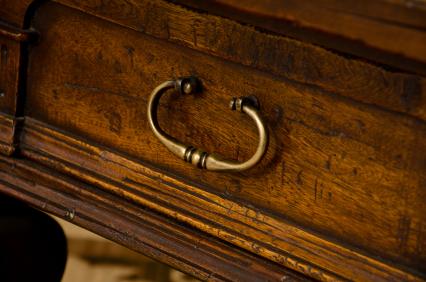Patina: It Gives Your Furniture Personality
Media Gallery
You’ve probably heard that you’re not supposed to destroy furniture’s patina when you refinish it. This is especially true of antiques. But exactly what is patina? The short answer is: you’ll know it when you see it.
The long answer is a little more complex. Just as your favorite jeans and T shirt get softer, more comfortable, and more yours with every wearing and washing, wooden furniture gets better with time and use. Wood naturally changes color over time, even when protected. Sunlight, dusting, polishing, and even the dings and scrapes that take place during everyday life add character to a piece of furniture. Sharp edges round out and clear finishes, like shellac and oil, deepen in color.
You’ll notice that old pieces, especially those that have been well cared for, seem to glow. The color of the wood also seems softer, somehow. That’s patina.
Stripping furniture down to bare wood destroys its patina, and the only way to restore an authentic patina is through time. That’s one of the reasons that refinishing valuable antiques is such a bad idea. The value of such a piece drops dramatically when the natural wear and tear on the item (in essence, its history) is obliterated.
Preserving an antique patina isn’t so hard; basically, you just need to care for the piece as you would any other piece of furniture. Avoid a true refinishing job. If that sideboard is looking a little worse for the wear, a good cleaning or gentle restoration can bring back its natural glow without causing its value to diminish substantially.
If you’re working with an item that’s not valuable, and you’re not crazy about its current finish, all this may not be a big concern to you. An authentic patina will develop over time; if well cared for, that table you’re refinishing today will look better in ten years and even better in twenty!
Of course, there are ways to create that patina furniture look without waiting for it to occur naturally. Furniture with applied patinas will never look exactly like an authentically aged piece, but depending on the techniques you use, you can pull off a reasonable lookalike.
One method of aging a piece involves bleaching it in the sun; simply leave the unfinished piece in a sunny spot for a few days. Some woods bleach faster than others, so you’ll have to experiment. Just make sure you bring it in at night so it doesn’t collect dew! Once the desired shade is achieved, finish the wood with shellac or oil.
Distressing a piece by sanding down corners and edges (anywhere natural wear would occur), denting it with heavy objects, or other abuse can also help your furniture look older and more authentic. Take it a step further by coating an old shelf or cabinet with several coats of paint before distressing it; the lower layers will show through, giving the illusion that the piece has been redone many times over the years. Alternatively, try one of the specially formulated paints that create a crackle finish.


